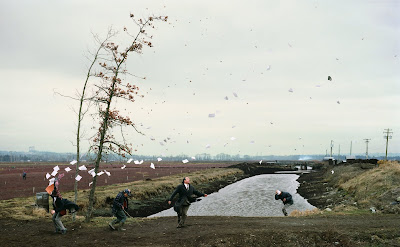



The entry of Henri de Lorraine, Marquis de Moy; in the upper part, musicians on a carriage in the shape of a phoenix on the left, and Henri de Lorraine dressed as Pyrandre, with eight soldiers, riding a salamander led by Cupid riding a swan; below, carriages symbolizing, from left to right, Perseverance led by Time, Constancy led by a dragon, and Faithfulness led by dogs. 1627

 some text from a dealer, Harris Schrank of New York ...
some text from a dealer, Harris Schrank of New York ...
not yet sure if it helps to describe the images above ...
Watermarks: L. 577, 579, 580, 583 with the Interlaced C watermark (Lieure watermark 29); L. 582 with the 4 Lorrain watermark (Lieure watermark 35).
In Plate 578, the Entree of MM De Vroncourt, there are in the distance two small boats. This confirms that this plate is a first state; in the second state (Fagnani) impressions these have been effaced. On Plate 583 Lieure describes in vague terms a very rare first state with some problematic lines in the curtain at the right, corrected later. Our impression has some weak lines, as have several other very early impressions we have examined; it also has an early watermark; it is quite probable that ours is a first state or that no such first state as described by Lieure exists.
The 10 prints in the Combat series were created to commemorate a tournament sponsored by Duke Charles IV of Lorraine, in his palace at Nancy, in honor of his beautiful cousin the Duchess of Chevreuse who was in exile at Lorraine after the discovery of her role in the plot against Richelieu. The Duke and his cousin the Prince of Phalbourg fought for her favor in an evening joust – the fight itself is shown in the culminating plate.
The series shows Callot at his best in a range of motifs, showing crowds and individuals, astonishing details and marvelous compositions, reality and invention, all etched splendidly.
Callot's illustrations eventually were included in a book on the event written by the blind court poet Henry Humbert. Various floats, chariots and individuals are shown entering the arena. Humbert writes of the entry of Vroncourt, Tyllon and Marimont: "They were raised up on a dolphin, armed with silver armor...Before their machine was seen Arion carried by another dolphin in the middle of the waves of the sea, who fondly touching his lute, blended his harmonies with the accidents of his voice." The entry of the Duke (the star) is described thus: "Vulcan with the nude Cyclops appeared next in a grotto, at the rear of which was a blazing furnace, where these dark artisans forged the arms of the sun.." (Callot had in fact designed the chariot of the forge of Vulcan.)
AND THEN ...
as a very tardy afterthought, after my evening's walk up to Castle Hill, I went back to the BNF Gallica site and searched for Henry Humbert ... and found at last the whole damned book, text and illustrations complete, and the images are wonderfully zoom-zoom-zoom-able ...
https://gallica.bnf.fr/ark:/12148/btv1b8617151n/f1.image.r=henry%20humbert
a very satisfying end to a day's ditherings
PS
Marie de Rohan, La Duchesse de Chevreuse
as portrayed later in the same year, probably by Claude Derouet, who was court painter at Lorraine and a friend of Jacques Callot


























